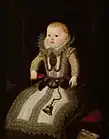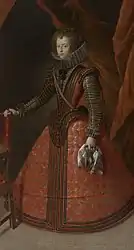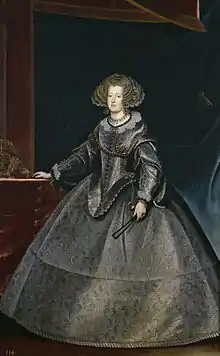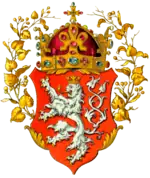Maria Anna of Spain
Maria Anna of Spain (18 August 1606 – 13 May 1646)[1] was a Holy Roman Empress and Queen of Hungary and Bohemia by her marriage to Ferdinand III, Holy Roman Emperor.[2] She acted as regent on several occasions during the absences of her husband, notably during his absence in Bohemia in 1645.[3]
| Maria Anna of Spain | |||||
|---|---|---|---|---|---|
 Portrait of Maria Anna by Diego Velázquez, 1630 | |||||
| Holy Roman Empress; German Queen; Archduchess consort of Austria | |||||
| Tenure | 15 February 1637 – 13 May 1646 | ||||
| Queen consort of Hungary, Bohemia and Croatia | |||||
| Tenure | 20 February 1631 – 13 May 1646 | ||||
| Coronation | 14 February 1638, St. Martin's Cathedral | ||||
| Born | 18 August 1606 El Escorial, Spain | ||||
| Died | 13 May 1646 (aged 39) Linz, Austria, Holy Roman Empire | ||||
| Burial | |||||
| Spouse | Ferdinand III, Holy Roman Emperor | ||||
| Issue | Ferdinand IV, King of the Romans Mariana, Queen of Spain Leopold I, Holy Roman Emperor | ||||
| |||||
| House | Habsburg | ||||
| Father | Philip III of Spain | ||||
| Mother | Margaret of Austria | ||||
| Religion | Roman Catholicism | ||||
| House of Habsburg Spanish line |
|---|
.svg.png.webp) |
|
Emperor Charles V (King Charles I) |
|
| Philip II |
| Philip III |
| Philip IV |
| Charles II |
The daughter of King Philip III of Spain and of Margaret of Austria, she was prior to her Imperial marriage considered a possible wife for Charles, Prince of Wales. The event, later known in history as the "Spanish match", provoked a domestic and political crisis in the Kingdoms of England and Scotland. In the imperial court in Vienna, she continued to be strongly influenced by her native Spanish culture from clothes to music and also promoted the strengthening of relations between the Imperial and the Spanish branches of the House of Habsburg.
Life
Early life
Infanta Maria Anna of Spain was born in the Palace of El Escorial, near Madrid, on 18 August 1606 as the fourth child and third (but second surviving) daughter of King Philip III of Spain and his wife, Margaret of Austria, Archduchess of the Inner Austrian branch of the House of Habsburg. Of her seven siblings, only four survived infancy: Anna (later wife of King Louis XIII of France), Philip IV of Spain, Charles (who died young in 1632) and Ferdinand (later Cardinal-Infante and Governor of the Spanish Netherlands). Maria Anna's parents had a close kinship; her father was her mother's first cousin once removed, and they were related through multiple lines of descent. On her father's side, she was the granddaughter of King Philip II of Spain, and his fourth wife and niece, Archduchess Anna of Austria, and on her mother's side, she was the granddaughter of Charles II, Archduke of Inner Austria and his wife and niece, Princess Maria Anna of Bavaria.
Betrothal
From early childhood, Maria Anna played an important role in the matrimonial projects of her father. In adolescence, she was betrothed to Archduke John-Charles, eldest son and heir of Ferdinand II, Holy Roman Emperor, and his first wife, Maria Anna of Bavaria. Her fiancé was her first cousin and the son of her mother's brother. The marriage never took place because of Archduke John-Charles's early death in 1618.[4]
In 1622, King James I of England received an offer from Philip IV of Spain to strengthen the relations of their countries through a dynastic marriage between Charles, Prince of Wales, and Infanta Maria Anna. London and Madrid began active negotiations. The possible marriage between the Prince of Wales and the Spanish Infanta was known in history under the name "Spanish match" and caused an internal political crisis in both England and Scotland. In 1623, the Prince of Wales, accompanied by George Villiers, 1st Duke of Buckingham, visited Madrid to meet his intended bride.[5] However, Maria Anna did not wish to marry a Protestant, and Charles would not convert to Catholicism. At the end, the wedding never took place for political reasons but also because of the reluctance of the new Spanish King to conclude a dynastic marriage with the House of Stuart.[6][7][8][9] Charles eventually married the devout Catholic Henrietta Maria of France of the House of Bourbon.
Marriage
In late 1626, Maria Anna was betrothed to Ferdinand, the younger brother of her first fiancé and the new heir of Emperor Ferdinand II. He was her first cousin and was the son of her mother's brother. The formal engagement was preceded by a series of negotiations, which were conducted in 1625. The same year, Ferdinand was crowned King of Hungary, and in 1627, he was crowned King of Bohemia. In the negotiations were included all the life aspects of the Infanta at the court of her future spouse. Despite the desire of the groom for Maria Anna's confessor to be the Jesuit Ambrosio Peñalosa, the appointment eventually went to Capuchin Diego Quiroga. In the marriage contract signed by both parties in 1628, it was noted that Maria Anna could retain her rights of inheritance over the Spanish throne, but her older sister Infanta Anna, who married to King Louis XIII of France in 1615, was forced to renounce her rights.[6][8][10]
Maria Anna had left Madrid for Vienna in December 1629, fully three years after her engagement and nearly five years after the proposal for marriage was first mooted. The journey, once it was embarked upon, took more than a year to complete. On route by sea, in Genoa, complications arose from an epidemic of the plague that erupted in the Italian Peninsula. For that reason, the party was unable to stop in Bologna, where Cardinal Antonio Barberini, nephew of Pope Urban VIII, was waiting for the Infanta to give her the Golden Rose. The party moved to Naples, where Maria Anna finally received the award. Leaving Naples, the Infanta crossed the Papal States after she had made a pilgrimage to the Basilica della Santa Casa. On that section of her journey, Maria Anna was accompanied by Roman aristocracy, led by another nephew of Pope Urban VIII, Taddeo Barberini, Prince of Palestrina. On 26 January 1631, she arrived in Trieste, where she met Archduke Leopold Wilhelm of Austria, her future brother-in-law, who would first stand in for his brother at a wedding by proxy and then escort the Infanta to Vienna.[11][12] The very day, Maria Anna was married to King Ferdinand of Hungria-Bohemia per procura, with Archduke Leopold Wilhelm serving as the proxy.
Before the official wedding, King Ferdinand, not trusting the previous portraits that he had seen of the Infanta, decided to view his bride secretly. The Royal Oberhofmeister asked for an audience with Maria Anna. On that visit, he was accompanied by some nobles, one of whom was her groom. Struck by the beauty of the Infanta, King Ferdinand immediately revealed his identity and began a conversation with Maria Anna in Spanish.[13] The love and respect that the future emperor felt for his wife lasted throughout their marriage. He was never unfaithful to her and never had any illegitimate children.[14]
In Vienna on 20 February 1631,[1] Maria Anna was married to King Ferdinand of Hungary-Bohemia. The festivities lasted a whole month. The marriage was described as friendly. Maria Anna was described as happy-tempered, friendly and intelligent, and she relieved the feelings of the rather melancholic Ferdinand.
Holy Roman Empress and German Queen
%252C_por_Felipe_Diriksen.jpg.webp)
Maria Anna arrived at the Imperial court in Vienna with the Spanish fashion, theatre, dance and music (including the first sounded guitar). As the wife of the heir, she maintained good relations with all members of her husband's family, but she had a complicated relationship with Ferdinand's stepmother, Empress Dowager Eleonora Gonzaga, mainly because a competition between them began for influence at the Imperial court. Maria Anna also paid much attention to the arts, especially painting. She collected works of Italian, Spanish and Flemish painters of the late Renaissance and early Baroque periods.[6][15]
In Regensburg on 22 December 1636, Ferdinand was elected as King of the Romans, and a week later, he was crowned by the Archbishop of Mainz. Maria Anna was crowned Queen of Germany one month later, on 21 January 1637. After his father's death, on 15 February 1637, Ferdinand became Holy Roman Emperor under the regnal name of Ferdinand III and also became sovereign King of Hungary and Bohemia. As his wife, she received the titles of Holy Roman Empress and sovereign Queen. Her coronation as Queen of Hungary took place in Pressburg during the Hungarian Diet of 1637–1638.[16][17]
Maria Anna, being active in politics as the adviser of her spouse, was an important mediator between the Emperor and their Spanish relatives. Although she always defended the interests of her husband, she did not forget the interests of her brothers King Philip IV and the Cardinal-Infante.[18] In her court, which was consisted mainly of Spaniards, frequent guests were the Spanish ambassador and other diplomats. The Emperor, during his absences from the Imperial court in Vienna, appointed his wife as regent, such as in 1645, during the Thirty Years' War, when he was in the Kingdom of Bohemia.[14]
Death
In March 1645 Maria Anna and her children left Linz because of the approach of the Protestant Swedish army and moved to Vienna. By April, it was ready to cross the Danube there and threatened to occupy the city. The Imperial family fled instead temporarily to Graz.[19] After returning to Vienna, it was forced to move again to Linz because of the plague. Maria Anna's sixth pregnancy became known in January 1646. Four months later, on 12 May at Linz Castle, she suddenly felt ill with fever and heavy bleeding and died the next morning. Her unborn child, a girl, was taken out alive from her womb. She was named Maria after her mother but lived only a few hours. On 24 May, both mother and daughter in the same coffin were moved to Vienna and buried in the Imperial Crypt, which already contained the coffins with the remains of the two sons of the Empress who had died earlier. The funeral cortege was accompanied by the Spanish ambassador and the Empress's maid of honor. Very upset by the death of his wife and child, the Emperor was unable to attend the funeral.[20][21] However, after returning to Vienna in late August, he finally paid his respects to the remains of Maria Anna, and in September, he announced the engagement of their eldest daughter, Maria Anna, with Balthasar Charles, Prince of Asturias. However, the Prince died the following month shortly after the announcement. The Spaniards courtiers, members of the late Empress' household who came with her from Spain, including her confessor and the maids of honour of the late Empress, stayed at the Imperial court in Vienna and lived there for a few more years after her death.[22]
Issue
During her marriage, Maria Anna gave birth to six children:[23]
- Ferdinand IV (8 September 1633 – 9 July 1654), King of the Romans and titular King of Hungary and Bohemia.
- Maria Anna (22 December 1634 – 16 May 1696), who married her maternal uncle King Philip IV of Spain.
- Philip August (15 July 1637 – 22 June 1639), Archduke of Austria.
- Maximilian Thomas (21 December 1638 – 29 June 1639), Archduke of Austria.
- Leopold I, Holy Roman Emperor (9 June 1640 – 5 May 1705).
- Maria (born and died 13 May 1646), Archduchess of Austria.
Ancestors
| Ancestors of Maria Anna of Spain | |||||||||||||||||||||||||||||||||||||||||||||||||||||||||||||||||||||||||||||||||||||||||||||||||||||||||||||||||||||||||||||||||||||||||||||||||||||||||||||||||||||||||||||||||||||||||||||||||||||||||||||||||||||||||||||||||||||||||||||||||||||||||||||||||||||||||||||||||||||||||
|---|---|---|---|---|---|---|---|---|---|---|---|---|---|---|---|---|---|---|---|---|---|---|---|---|---|---|---|---|---|---|---|---|---|---|---|---|---|---|---|---|---|---|---|---|---|---|---|---|---|---|---|---|---|---|---|---|---|---|---|---|---|---|---|---|---|---|---|---|---|---|---|---|---|---|---|---|---|---|---|---|---|---|---|---|---|---|---|---|---|---|---|---|---|---|---|---|---|---|---|---|---|---|---|---|---|---|---|---|---|---|---|---|---|---|---|---|---|---|---|---|---|---|---|---|---|---|---|---|---|---|---|---|---|---|---|---|---|---|---|---|---|---|---|---|---|---|---|---|---|---|---|---|---|---|---|---|---|---|---|---|---|---|---|---|---|---|---|---|---|---|---|---|---|---|---|---|---|---|---|---|---|---|---|---|---|---|---|---|---|---|---|---|---|---|---|---|---|---|---|---|---|---|---|---|---|---|---|---|---|---|---|---|---|---|---|---|---|---|---|---|---|---|---|---|---|---|---|---|---|---|---|---|---|---|---|---|---|---|---|---|---|---|---|---|---|---|---|---|---|---|---|---|---|---|---|---|---|---|---|---|---|---|---|---|---|---|---|---|---|---|---|---|---|---|---|---|---|---|---|---|---|
| |||||||||||||||||||||||||||||||||||||||||||||||||||||||||||||||||||||||||||||||||||||||||||||||||||||||||||||||||||||||||||||||||||||||||||||||||||||||||||||||||||||||||||||||||||||||||||||||||||||||||||||||||||||||||||||||||||||||||||||||||||||||||||||||||||||||||||||||||||||||||
Depictions in art
Claire Jowitt views the character of princess Donusa in Massinger's 1624 play The Renegado as an allegory of the Infanta during the failed marriage attempt.[30]
In 1634, the Spanish poet and playwright Pedro Calderón de la Barca, in honour of the victory of the Spaniards and the Austrians over the Swedes in the Battle of Nördlingen, set in Madrid a performance in which Maria Anna, with her husband, was one of the actors.[31]
Save a few portraits of Maria Anna as child, almost all of them are included in the collection of the Kunsthistorisches Museum in Vienna. In the earliest of those paintings, made by Juan Pantoja de la Cruz, she is shown at one year of age.[32] The collection of the Portland Art Museum includes a 1630s portrait of Maria, painted by Felipe Diriksen. A portrait of the Infanta Maria Anna, then Queen of Hungary and Bohemia, made by Diego Velázquez, court painter at Madrid, was part of the collection of the Museo del Prado.[33] Portraits of the Empress made by Frans Luycx (painter at the court in Vienna), Bartolomé González y Serrano, Rodrigo de Villandrando, Justus Sustermans, Juan van der Hamen and other unknown authors are also stored in the collections of the Kunsthistorisches Museum,[34] Museo del Prado,[35] the gallery of the Schloss Esterházy in Eisenstadt[36] and the Musée Fesch in Ajaccio.[37]
 Infantin Maria Anna, Kaiserin, im Alter von 4 bis 5 Monaten, Bildnis in ganzer Figur (1607), by Juan Pantoja de la Cruz, Kunsthistorisches Museum, Vienna.
Infantin Maria Anna, Kaiserin, im Alter von 4 bis 5 Monaten, Bildnis in ganzer Figur (1607), by Juan Pantoja de la Cruz, Kunsthistorisches Museum, Vienna. Maria Anna, Infanta of Spain, Later Archduchess of Austria, Queen of Hungary and Empress, as a child, by Bartolomé González y Serrano, National Trust, Cliveden.
Maria Anna, Infanta of Spain, Later Archduchess of Austria, Queen of Hungary and Empress, as a child, by Bartolomé González y Serrano, National Trust, Cliveden. Infantin Maria Anna, Kaiserin, in ganzer Figur (1617), by Bartolomé González y Serrano, Kunsthistorisches Museum, Vienna.
Infantin Maria Anna, Kaiserin, in ganzer Figur (1617), by Bartolomé González y Serrano, Kunsthistorisches Museum, Vienna. Retrato de la infanta María Ana de Austria (1630), by Felipe Diricksen, Portland Art Museum
Retrato de la infanta María Ana de Austria (1630), by Felipe Diricksen, Portland Art Museum

 Ölgemälde von Ferdinand III. von Habsburg und seiner ersten Gemahlin Maria Anna von Spanien (1628/30) by Justus Sustermans, Schloss Esterházy, Eisenstadt.
Ölgemälde von Ferdinand III. von Habsburg und seiner ersten Gemahlin Maria Anna von Spanien (1628/30) by Justus Sustermans, Schloss Esterházy, Eisenstadt. Infantin Maria Anna, Kaiserin, in ganzer Figur mit ihrem erstgeborenen Sohn Ferdinand (1634), Anonymous, Kunsthistorisches Museum, Vienna.
Infantin Maria Anna, Kaiserin, in ganzer Figur mit ihrem erstgeborenen Sohn Ferdinand (1634), Anonymous, Kunsthistorisches Museum, Vienna.
Notes
- Eduard Heydenreich: Handbuch Der Praktischen Genealogie, p. 52, BoD – Books on Demand 2012 - 448 p. [retrieved 1 November 2016].
- "Ferdinand III". Encyclopædia Britannica.
- Hengerer M. Kaiser Ferdinand III. (1608—1657). Eine Biographie. Wien, Köln, Weimar : Böhlau Verlag, 2012. (Veröffentlichungen des Instituts für Österreichische Geschichtsforschung). — ISBN 978-3-205-77765-6.
- Ludwig Albrecht Gebhardi: Genealogische Geschichte der erblichen Reichsstände in Teutschland; Halle: Johann Jacob Gebauer, 1779, vol. II, p. 519. [retrieved 1 November 2016].
- Wurzbach, Constantin, von, ed. (1861). . Biographisches Lexikon des Kaiserthums Oesterreich [Biographical Encyclopedia of the Austrian Empire] (in German). Vol. 7. p. 23 – via Wikisource.
{{citation}}: CS1 maint: multiple names: editors list (link) - Beatrix Bastl, Jose Luis Colomer: Dos infantas españolas en la corte imperial [retrieved 1 November 2016].
- Pauline Gregg King Charles I - The Spanish Match, pp. 72–89. [retrieved 1 November 2016].
- Braun, Keller, Schnettger 2016, p. 144.
- Hengerer 2012, p. 57.
- Hengerer 2012, p. 57, 64.
- Francesca Quatrini: Eleonora d’Austria, Maria Anna d’Asburgo-Spagna e Maria Ludovica Gonzaga Nevers – tre regine in viaggio nell’Europa moderna. Sigla del settore scientifico-disciplinare Archived 15 September 2016 at the Wayback Machine [retrieved 1 November 2016].
- Hengerer 2012, p. 85.
- Hengerer 2012, pp. 85–86.
- Hengerer 2012, pp. 130–131.
- Braun, Keller, Schnettger 2016, pp. 146–148.
- Hengerer 2012, p. 172.
- R. Bireley: Ferdinand II, Counter-Reformation Emperor, 1578 — 1637. Cambridge: Cambridge University Press 2014, p. 302 ISBN 978-1-10-706715-8.
- Braun, Keller, Schnettger 2016, p. 152.
- Hengerer 2012, pp. 230–231.
- Hengerer 2012, p. 247.
- Braun, Keller, Schnettger 2016, pp. 141–142.
- Hengerer 2012, p. 249.
- Martin Mutschlechner: Ferdinand III – Ehen und Nachkommen [retrieved 1 November 2016].
- Kurth, Godefroid (1911). . In Herbermann, Charles (ed.). Catholic Encyclopedia. Vol. 12. New York: Robert Appleton Company.
- Wurzbach, Constantin, von, ed. (1861). . Biographisches Lexikon des Kaiserthums Oesterreich [Biographical Encyclopedia of the Austrian Empire] (in German). Vol. 7. p. 120 – via Wikisource.
{{citation}}: CS1 maint: multiple names: editors list (link) - Wurzbach, Constantin, von, ed. (1860). . Biographisches Lexikon des Kaiserthums Oesterreich [Biographical Encyclopedia of the Austrian Empire] (in German). Vol. 6. p. 151 – via Wikisource.
{{citation}}: CS1 maint: multiple names: editors list (link) - Wurzbach, Constantin, von, ed. (1860). . Biographisches Lexikon des Kaiserthums Oesterreich [Biographical Encyclopedia of the Austrian Empire] (in German). Vol. 6. p. 352 – via Wikisource.
{{citation}}: CS1 maint: multiple names: editors list (link) - Wurzbach, Constantin, von, ed. (1861). . Biographisches Lexikon des Kaiserthums Oesterreich [Biographical Encyclopedia of the Austrian Empire] (in German). Vol. 7. p. 13 – via Wikisource.
{{citation}}: CS1 maint: multiple names: editors list (link) - Wurzbach, Constantin, von, ed. (1861). . Biographisches Lexikon des Kaiserthums Oesterreich [Biographical Encyclopedia of the Austrian Empire] (in German). Vol. 7. p. 20 – via Wikisource.
{{citation}}: CS1 maint: multiple names: editors list (link) - Jowitt, C. (2004); Massinger's The Renegado (1624) and the Spanish marriage, Cahiers Elisabethains, 65, p 45–53
- Hengerer 2012, p. 107.
- Infantin Maria Anna (1606-1646), Kaiserin, im Alter von 4 bis 5 Monaten, Bildnis in ganzer Figur in: www.khm.at [retrieved 1 November 2016].
- Doña María de Austria, reina de Hungría in: www.museodelprado.es [retrieved 1 November 2016].
- Die Habsburger — Maria Anna von Spanien, Kaiserin in: www.khm.at [retrieved 1 November 2016].
- Doña María Ana de Austria, reina de Hungría in: www.museodelprado.es [retrieved 1 November 2016].
- Ez világ, mint egy kert... in: esterhazy.at Archived 27 March 2014 at the Wayback Machine [retrieved 1 November 2016].
- Spanish Baroque Art in: www.spanishbaroqueart.com [retrieved 1 November 2016].
References
- Bettina Braun, Katrin Keller, Matthias Schnettger: Nur die Frau des Kaisers?: Kaiserinnen in der Frühen Neuzeit, Böhlau ed., Vienna 2016 ISBN 978-3-20-520085-7.
- M. Hengerer: Kaiser Ferdinand III. (1608—1657). Eine Biographie Archived 23 September 2015 at the Wayback Machine, Böhlau ed., Vienna, Köln, Weimar 2012 ISBN 978-3-205-77765-6.
- Habsburg, Maria Anna von Spanien, Biographisches Lexikon des Kaiserthums Oesterreich, Vienna Kaiserlich-königliche Hof- und Staatsdruckerei, p. 52 – 458 p.

.svg.png.webp)